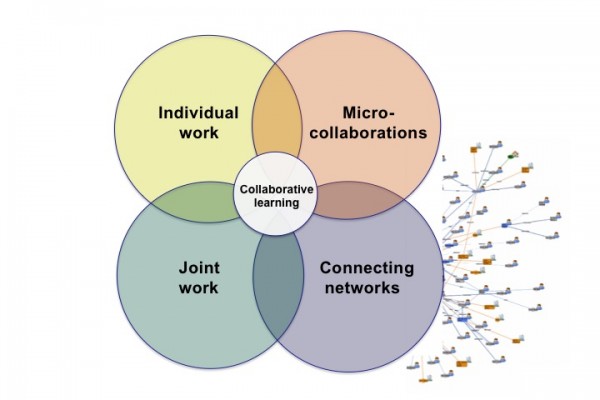“What makes a network alive is that there is collective learning happening. That’s the glue and the relationships are in support of that. If our goal is to collectively learn something, those are the networks or the communities that keep on going.” – Ria Baeck, on the Living Love Podcast
What allows groups to co-create and sustain connection? In my conversation with Ria, who has decades of experience hosting groups, I resonated with her point that the shared learning is what creates aliveness. I too had recognized the importance of putting collaborative learning at the center of how we work.
We need a way to see how our individual work connects with larger communities and to realize that each of those relationships can be an avenue for information, resources, and new ideas to be exchanged. To help with seeing the relationships and potential for collaborative learning, I developed this framework:

With good design and facilitation, each meeting can generate benefits and connect learning within these dimensions.
Below, I highlight the range of benefits that collaborative work can generate. There are many tools and methods for how to do this. I have linked to blogs if you’d like to learn more.
Individual Benefits
- Help me advance the work currently on my plate.
- Make new connections and/or strengthen relationships that can help my current or future work.
- Deepen my understanding about the community, issues, equity dynamics, and/or larger systems I am working within. Help me see my niche and appropriate role, e.g., how can my skills best contribute to what is needed in my organization/community.
- Access new information and resources – both that I can gain and what I can share. Spark my curiosity about new areas to learn about or invest in.
- Clarify my own thinking; reflect and make meaning of my experience, e.g., by having an opportunity to talk and be listened to and have meaningful conversations.
Micro-Collaboration/Relationship Benefits
- Enable people to find each other who have the same or complementary interests. Open doors of opportunity for others. (See Quick Maps, Closing Triangles, and Network Mapping)
- Deepen understanding of other’s work, ideas and perspectives and surface my blind spots (e.g., connecting across siloes, deepening dialogue). (See 1-2-4-All and World Café)
- Create opportunities to spark new “micro-collaborations” (e.g., two or three people working together, meeting for coffee to find ways to help each other’s work, sharing information/making introductions). (See Micro-Collaborations)
- Strengthen trust, care, and good will for each other.
- Build skills in listening and collaborative leadership. (See Listening)
“It’s not just about delivering content to members, it’s about the convening power to help members discover each other.” – Clay Shirky
Joint Work Benefits
- Deepen the shared understanding of the history and dynamics of the systems we are working within, particularly highlighting the perspectives and agency of those marginalized.
- Access the best thinking of each participant and enable these ideas and experiences to synthesize and cross-pollinate.
- Align a group around a shared purpose.
- Connect and amplify many voices to have a stronger common voice.
- Gather ideas and prioritize them to determine the wisest strategy and actions to take now.
- Do more together than anyone could alone.
Connecting Networks and Communities of Practice
Each member of a team/organization/network can be a conduit to share learning from this work into their other networks and learning communities and vice versa. Here are some examples: (See Invest in the Field and Peer Learning Network)
- Teams or organizations can connect to others doing similar work for learning exchange (e.g., community of practice).
- Each role in an organization can connect to learning communities of those who do that same role for sharing best practices and learning (e.g., urban sustainability officers, non-profit executive directors, facilitators). Professional associations, following and sharing on social media, and communities of practice are all places to share learning.
- Each team or organization is nested within a larger one (e.g., a town is part of a county, which is part of a state). Insights and learning can be shared within and across these levels.
- Various processes and tools to do work each have networks to share and exchange learning (such as this community of Network Weavers, the National Coalition for Dialogue & Deliberation (NCDD) which connects those facilitating dialogue, and Art of Hosting, a global learning network of thousands connecting on how to host conversations that matter).
Collaborative Learning is at the Center
Each of these four dimensions contribute to collaborative learning for the whole group and that learning can generates benefits for each dimension. At each level, information, conversation, and exchange flow in all directions to increase the collaborative learning potential of the group.
Learn More
Subscribe to the Living Love podcast for more episodes about how to create conditions for collaboration and strong community.
